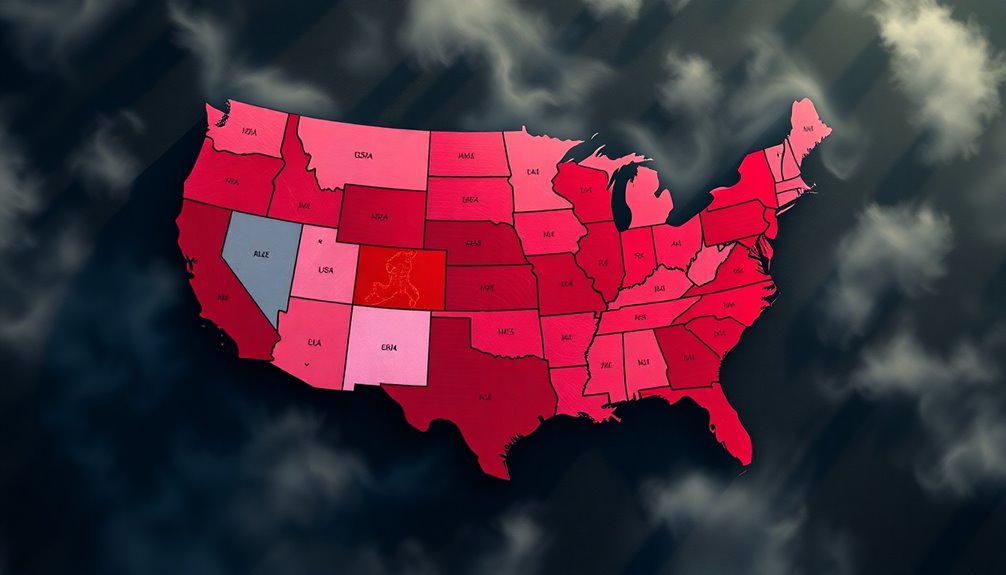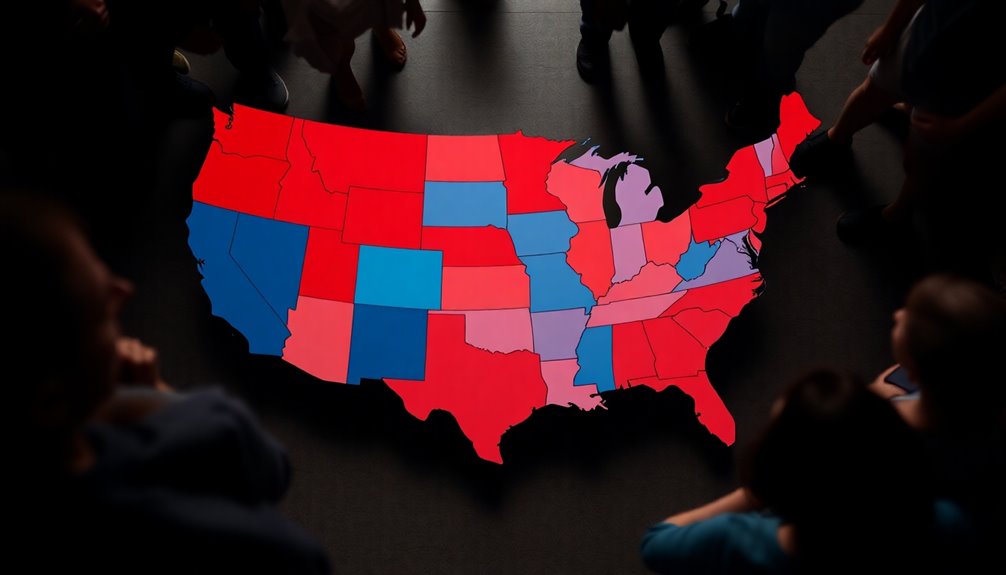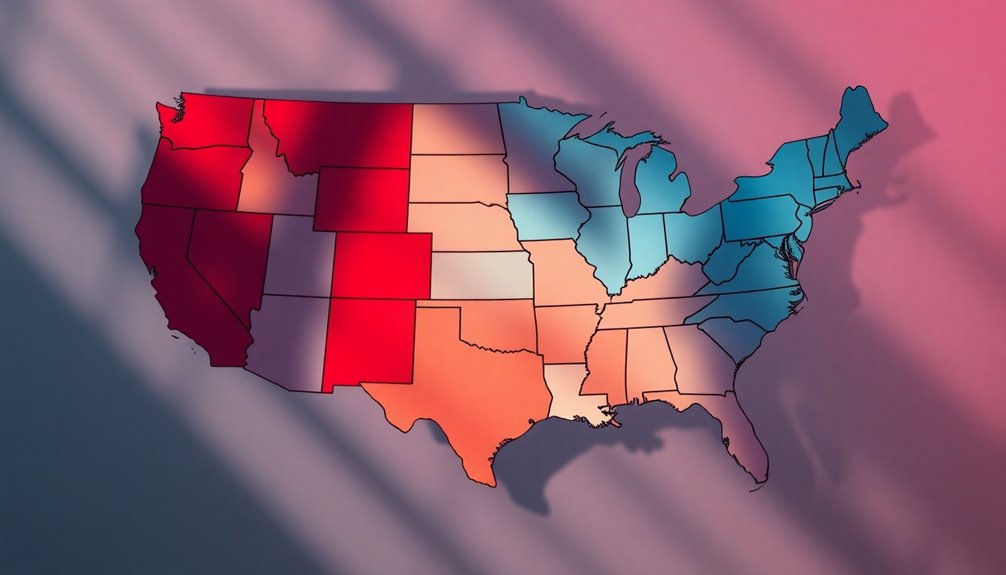If you're curious about which states have the most registered sex offenders, Texas tops the list with over 75,000 offenders. California follows with around 60,615, while New York comes in third with about 42,985 registered offenders. Michigan and Illinois also contribute significantly, with approximately 40,391 and 34,056 offenders, respectively. Interestingly, when you look at rates per capita, Oregon has the highest at 790 offenders per 100,000 residents. These statistics highlight the complexities of registration laws and offender demographics across the country. There's much more to uncover about this topic and its implications.
Key Takeaways
- Texas has the highest number of registered sex offenders, exceeding 75,000.
- California ranks second with approximately 60,615 registered offenders.
- New York follows in third place with around 42,985 offenders.
- Michigan reports about 40,391 registered sex offenders, making it fourth nationally.
- Illinois rounds out the top five with approximately 34,056 offenders.
States With Most Offenders

When looking at the states with the most registered sex offenders, Texas stands out with over 75,000 individuals on its registry, making it the largest in the nation. This number reflects both its massive population and comprehensive registration laws that encompass a wide range of offenses. California follows with around 60,615 registered offenders, while New York has approximately 42,985, placing it in the top three. Michigan and Illinois also have significant numbers, with about 40,391 and 34,056 registered offenders, respectively. Florida, Virginia, and North Carolina contribute to the list with substantial registries, showcasing how various states enforce and report sex offenses based on their populations and legal frameworks. The total number of registered sex offenders in the U.S. has reached over 795,000 offenders, indicating a growing concern for community safety.
Rates of Offenders Per Population

The distribution of registered sex offenders varies significantly across states when adjusted for population. For instance, Oregon leads with a staggering 790 offenders per 100,000 residents, while Arkansas follows with 640.
In contrast, Massachusetts boasts one of the lowest rates at just 79 offenders per 100,000 residents. Other states like Maryland and Connecticut maintain lower figures as well, at 117 and 124 respectively.
Southern states often report higher rates, with Arkansas and Alabama showing particularly elevated numbers. Approximately 300,000 women are victims of rape annually, which underscores the importance of understanding these rates.
Meanwhile, Midwestern states present a mixed picture, with Wisconsin at 459 and Michigan at 402.
Factors Influencing Registration Rates

Understanding the factors influencing registration rates for sex offenders requires examining a mix of state laws, county-level conditions, and individual characteristics.
States vary in their registration requirements, with some imposing stricter rules, like residency restrictions, which can affect compliance. Additionally, failure to register is typically classified as a felony, leading to criminal penalties, further complicating the registration landscape.
At the county level, housing affordability and population density play vital roles in the stability of registered sex offenders, impacting how often they move or fail to register.
On an individual level, factors such as age, minority status, and the type of victim can predict transience.
Additionally, if an offender has a history of failing to register, they're more likely to be transient, complicating the overall effectiveness of registration policies across different jurisdictions.
Specific Offense Rates by State

Sex offender registration rates can reveal significant patterns, but specific offense rates by state provide a clearer picture of the issue at hand.
For instance, Alaska leads with 328 reported rape offenses, translating to 74 offenses per 100,000 residents. South Dakota follows closely with 438 reported rapes at 53 per 100,000. Additionally, it is important to note that 91.4% of offenders are male, which highlights a concerning trend in offender demographics.
When it comes to fondling offenses, Montana ranks high, although exact rates aren't detailed. South Dakota also has alarming rates of child rape, indicating a pressing concern.
Overall, Alaska and Utah have the highest sex offense rates, with 171 and 159 offenses per 100,000 residents, respectively.
Understanding these specific rates helps you grasp the unique challenges each state faces regarding sexual offenses.
Regional Variations in Offender Rates

While examining regional variations in offender rates, you'll notice significant differences that stem from a mix of state laws, demographics, and enforcement practices.
For instance, Oregon leads with the highest rate of registered sex offenders, influenced by rigorous reporting and a broad range of offenses that require registration. In contrast, Maryland boasts the lowest rate, thanks to strict registration criteria.
States like Arkansas and Delaware show high rates due to prevalent crimes, while Indiana and Connecticut maintain lower rates through specific laws.
Population density and socio-economic factors also impact these numbers, with enforcement practices shaping public awareness and reporting trends. Furthermore, understanding the implications of SORN laws is crucial for addressing the complexities of sex offender registration across the country.
Frequently Asked Questions
How Are Sex Offenders Monitored After Registration?
After registration, sex offenders are monitored primarily through GPS technology.
You might wear a GPS device on your ankle, which actively tracks your movements. This device sends real-time location data to a monitoring center.
If you enter restricted areas or tamper with the device, alarms alert authorities.
This system not only ensures compliance with legal requirements but also enhances public safety by allowing for quick responses to violations.
What Rights Do Registered Sex Offenders Have?
As a registered sex offender, you have certain rights that protect you.
You're entitled to due process and can seek legal representation if accused of a crime. You have the right to a fair trial before registration becomes mandatory.
If you fail to register, it can lead to severe consequences, but states must also provide pathways for reducing or removing registration requirements.
Understanding these rights is crucial for navigating your situation effectively.
Can Registered Sex Offenders Move Freely?
No, registered sex offenders can't move freely. You must report your interstate move to law enforcement within a specific time frame, which varies by state.
If you don't, you could face severe legal consequences, including felony charges.
Additionally, some states impose residence restrictions, preventing you from living near schools or parks.
Always check the laws of your new state and consult a lawyer to ensure compliance before moving.
How Often Do Offenders Need to Update Their Registration?
You need to update your registration based on your offender tier.
Tier I offenders update annually, while Tier II offenders must do so every six months. If you're a Tier III offender, you'll update every 90 days.
Regardless of your tier, you must notify the jurisdiction of any changes in your name, residence, employment, or student status within three business days.
Staying compliant is crucial to avoid legal issues.
What Resources Are Available for Victims of Sex Offenses?
If you're a victim of a sex offense, there are numerous resources available to support you.
You can reach out to the National Sexual Assault Hotline at 800.656.HOPE for emotional support, or use their online hotline for instant messaging help.
The National Domestic Violence Hotline also offers 24/7 assistance.
Local organizations, like your community's Rape Crisis Hotline, provide tailored support.
Don't hesitate to seek help; you're not alone.
Conclusion
In conclusion, understanding the distribution of sex offenders across states helps shed light on the complexities of this issue. By examining offender rates per population, specific offenses, and regional variations, you can gain insights into the factors influencing these statistics. Ultimately, addressing the challenges related to sex offenses requires a comprehensive approach that considers these nuances, ensuring communities can effectively prioritize safety and support rehabilitation efforts for offenders.










